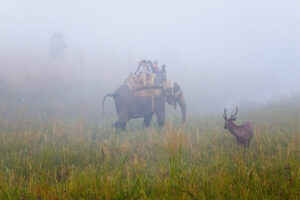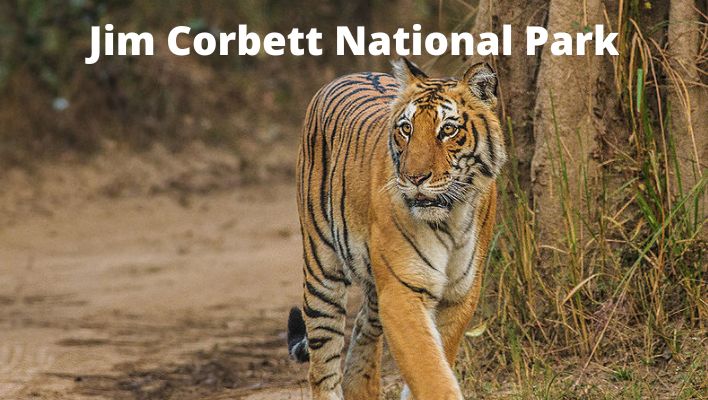Jim Corbett National Park is located in the Nainital district of Uttarakhand state in India. In 1936, during the British Raj, the first national park in India was formed and named Hailey National Park after William Malcolm Hailey, the governor of the United Provinces where it was located at the time. It was renamed Corbett National Park in 1956, about a decade after India’s independence, in honor of the hunter and naturalist Jim Corbett, who had been instrumental in its establishment and had died the previous year. The Jim Corbett National Park was the inaugural edition of the Project Tiger initiative.
The 520.8 km2 (201.1 sq mi) Jim Corbett National Park consists of hills, riverine belts, marshy depressions, grasslands, and a big lake. The elevation ranges from 400 to 1,220 metres (1,300 to 4,000 feet). Winter nights are chilly, however, winter days are bright and sunny. From July to September, it rains. The park features the geological and ecological characteristics of the sub-Himalayan belt. Sal, peepal, Rohini, and mango trees predominate in the dense moist deciduous forest. Approximately 73 percent of the park is covered by forest, while 10 percent consists of grasslands. It is home to approximately 110 tree species, 50 animal species, 580 bird species, and 25 reptile species.
When is Jim Corbett National Park formed?
A portion of the park previously belonged to the princely state of Tehri Garhwal. The Environment and Forests Department (Uttarakhand) removed the forests to make the region less susceptible to Rohilla invasion. In exchange for the East India Company’s assistance in expelling the Gurkhas from his territory, the Raja of Tehri formally ceded a portion of his princely realm to the company. The Buksas, a tribe from the Terai, arrived in the area and began cultivating crops, but they were expelled in the early 1860s when British authority was established.
The British officer in charge of the region during the 19th century, Major Ramsay, initiated efforts to preserve the region’s woodlands. In 1868, the British forest department acquired jurisdiction over the land and barred agriculture and the operation of cattle stations as the first step in the protection of the region. These forests were designated a reserve forest in 1879, with restricted felling privileges.
The reserve was renamed Ramganga National Park in 1954–55 and Corbett National Park in 1955–56, after the author and naturalist Jim Corbett. Several British citizens, including E. R. Stevans and E. A. Smythies, proposed the establishment of a national park on this land in the early 20th century. In 1907, the British government examined the prospect of establishing a game reserve there. The task of delineating such a region did not begin until the 1930s.
Jim Corbett National Park: Asia’s First National Park
Asia’s first national park, comprising 323,75 km2 (125,00 sq mi), was established in 1936 when Sir Malcolm Hailey was the Governor of the United Provinces and Hailey National Park was established. In the reserve, only timber cutting for domestic purposes was permitted. Regulations forbidding the killing and capture of mammals, reptiles, and birds inside the reserve’s boundaries were enacted shortly after its establishment.
During the 1930s, the park prospered under the elected government. During the Second World War, however, it suffered from rampant hunting and logging. Over time, the reserve expanded; in 1991, 797.72 km2 (300.00 sq mi) were added as a buffer zone to the Corbett Tiger Reserve. The expansion of 1991 encompassed the whole Kalagarh forest division, incorporating the 301.18 km2 (116.29 sq mi) Sonanadi Wildlife Sanctuary into the Kalagarh division. The site was chosen in 1974 to commence the Project Tiger animal conservation initiative. The reserve is managed from its headquarters in the district of Nainital.
Jim Corbett National Park is one of thirteen protected sites included by the Terai Arc Landscape Program of the World Wide Fund for Nature. The initiative intends to safeguard three of the five terrestrial flagship species, namely the tiger, the Asian elephant, and the great one-horned rhinoceros, by rebuilding forest corridors to connect 13 protected areas in Nepal and India in order to facilitate wildlife migration.
Ecotourism in Jim Corbett Park
Reserve management has supported tourists, despite the fact that the primary objective is wildlife conservation. To teach nature guides, a course on natural history, visitor management, and park interpretation was developed in 1993. In 1995, a second session hired additional guides for the same purpose. This allowed the employees of the reserve, who were previously busy escorting tourists, to engage in uninterrupted management operations. In addition, the Indian government has hosted ecotourism workshops in Jim Corbett National Park and the Garhwal region to ensure that local residents benefit from tourism while the park is preserved.

Between 15 November and 15 June 1991, the Jim Corbett National Park hosted 3,237 tourist vehicles transporting 45,215 tourists during the peak tourist season. This large number of tourists has caused evident indicators of ecological stress. A drop in plant species and a decrease in soil moisture have resulted from excessive soil tampering brought about by tourist activity.
The number of tourists who use fuel wood for cooking has increased. This is a source of worry because this firewood is acquired from surrounding forests, resulting in increased pressure on the park’s forest environment. In addition, tourists have caused problems by making noise, littering, and generally causing disruptions. Kahini Ghosh Mehta, a naturalist, and photographer published the first complete tourist guide to Corbett National Park in 2007.
Flora and Fauna of Jim Corbett National Park
The Jim Corbett National Park is situated between latitudes 29°25′ and 29°39′ North and longitudes 78°44′ and 79°07′ East. The region’s altitude ranges between 360 m (1,181 ft) and 1,040 m (3,280 ft) (3,412 ft). Numerous ravines, ridges, minor streams, and small plateaus with varying aspects and degrees of slope can be found on this terrain. The park encompasses the Ramganga river-formed Patli Dun valley. It safeguards portions of the moist deciduous forests of the Upper Gangetic Plains and the subtropical pine forests of the Himalayas. The climate is subtropical and mountainous.
In the Jim Corbett National Park, a total of 488 different plant species have been identified. The Sal forests within the reserve have a higher tree density than the Anogeissus-Acacia catechu forests. Total tree basal cover is greater in wooded areas dominated by Sal. The communities of Mallotus philippensis, Jamun, and Diospyros tomentosa are experiencing healthy regeneration in the sapling and seedling layers.
Bengal Tiger in Jim Corbett National Park
More than 586 species of resident and migratory birds, including the crested serpent eagle, blossom-headed parakeet, and red junglefowl – ancestor of all domestic fowl — have been classified. Also recorded are 33 species of reptiles, seven species of amphibians, seven species of fish, and 36 species of dragonflies.
Although Bengal tigers are abundant, they are difficult to identify due to the reserve’s abundance of greenery, which serves as camouflage. The dense jungle, the river Ramganga, and the abundance of prey make this reserve an ideal home for tigers, which are opportunistic eaters that prey on a variety of species. Tigers in the park have been observed killing considerably larger animals for food, including buffalo and even elephants. In exceptional instances of food scarcity, the tigers feed upon larger animals. There have been instances of tigers attacking domestic animals when food was scarce.
Leopards and other Animals
Leopards inhabit steep regions, however, they can also be found in lowland jungles. The Jim Corbett National Park is home to the jungle cat, the fishing cat, and the leopard cat. Other mammals include barking deer, sambar deer, hog deer and chital, sloth and Himalayan black bears, Indian grey mongoose, otters, yellow-throated martens, Himalayan goral, Indian pangolins, langur and rhesus macaques, and Indian grey mongoose. At night, owls and nightjars can be heard.
Several hundred Indian elephants can be observed in the summer. The Indian python inhabiting the reserve is a hazardous animal that is capable of killing a chital deer. Crocodiles and gharials in the region were saved from extinction by captive breeding projects that released crocodiles into the Ramganga river.

